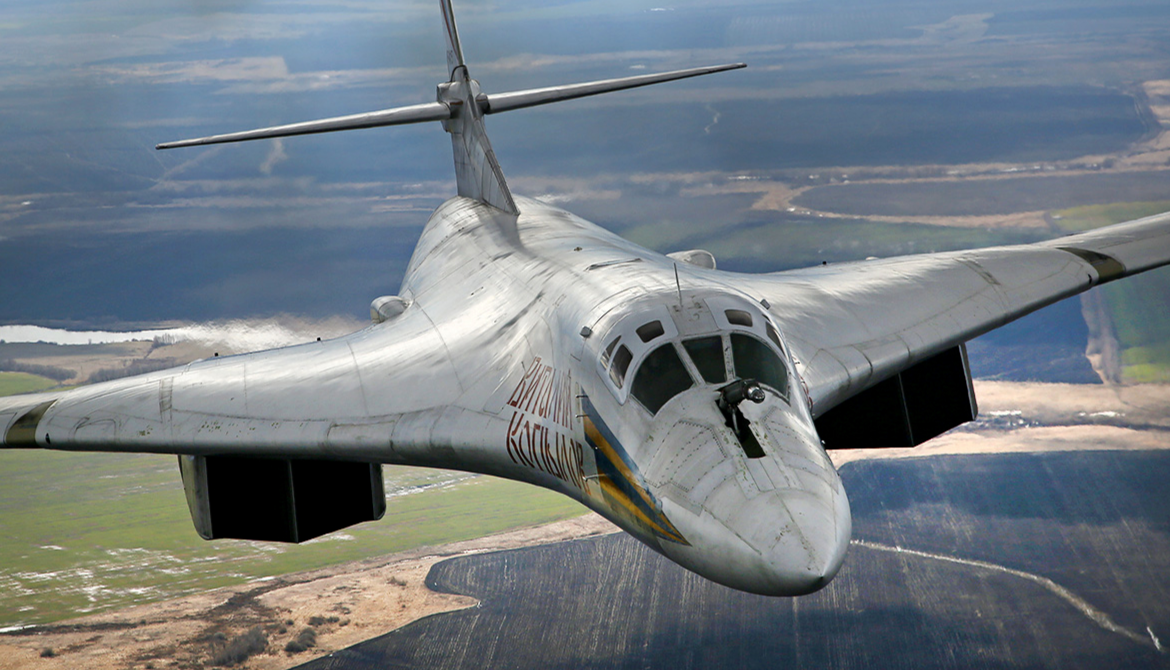Tupolev Design Bureau
Tu-160 Blackjack
 |
|
| Tupolev Tu-160 in flight over Russia, August 2005 | |
| Role | Supersonic strategic heavy bomber |
|---|---|
| National origin | Soviet Union / Russia |
| Design group | Tupolev |
| Built by | Kazan Aircraft Production Association |
| First flight | 18 December 1981 |
| Introduction | April 1987 |
| Status | In service |
| Primary users | Russian Aerospace Forces Soviet Air Forces (historical) Ukrainian Air Force (historical) |
| Produced | 1984–1992, 2002, 2008, 2017, 2021–present |
| Number built | 41 (9 test and 32 serial) |
|
|
.
History Public Joint Stock Company Tupolev,
Tupolev Tu-160 Blackjack

The Tupolev Tu-160 (Russian: Туполев Ту-160 Белый лебедь, romanized: Bely Lebed, lit. 'White Swan'; NATO reporting name: Blackjack) is a supersonic, variable-sweep wing nuclear-capable heavy strategic bomber and airborne missile platform designed by the Tupolev Design Bureau in the Soviet Union in the 1970s. It is the largest and heaviest Mach 2+ supersonic military aircraft ever built and second to the experimental XB-70 Valkyrie in overall length and top speed. As of 2024, it is the largest and heaviest combat aircraft, the fastest bomber in use and the largest and heaviest variable-sweep wing airplane ever flown. The Tu-160 is operated by the Long Range Aviation of the Russian Aerospace Forces.
Resumed production

In 2008, Russia revealed plans for one new Tu-160 to be delivered every one to two years with the aim of increasing the active inventory to 30 or more aircraft by 2025–2030. On 29 April 2015, Russian Defense Minister Sergei Shoigu, on order of President Putin, announced that Tu-160 production would resume. In May 2015, TASS reported that the Russian Air Force would purchase at least 50 KAPO-built Tu-160s. General Viktor Bondarev stated that development of the PAK DA will proceed alongside Tu-160 production.
On 16 November 2017, a newly assembled Tu-160, built from an unfinished airframe, was unveiled during a roll-out ceremony at KAPO, signifying a restoration of certain production techniques such as electron-beam welding or titanium work reportedly lost after the termination of serial production in 1992. According to Dmitri Rogozin, the serial production of wholly new airframes for the modernized Tu-160M2 should begin in 2019 with deliveries to the Russian Aerospace Forces in 2023. The aircraft, named Petr Deinekin, after the first commanding officer of the Russian Air Force, performed its maiden flight in January 2018 and began flight testing the same month. It performed its first public flight on 25 January 2018, during President Vladimir Putin's visit to KAPO plant
0
KmCeiling
0
KmCombat RANGE
0
MachAircraft Speed
0
Max Crew
Photo Gallery
Public Joint Stock Company Tupolev,
Tupolev Tu-160 Blackjack


Public Joint Stock Company Tupolev,
Tupolev Tu-160 Blackjack
General Info
-
-
-
-
- Crew: 4 (pilot, co-pilot, bombardier, defensive systems officer)
- Length: 54.1 m (177 ft 6 in)
- Wingspan: 55.7 m (182 ft 9 in) wings spread (20°)
-
-
-
- 35.6 m (117 ft) wings swept (65°)
-
-
- Height: 13.1 m (43 ft 0 in)
[
-
-
-
Powerplant
-
-
-
-
- Empty weight: 110,000 kg
- Gross weight: 267,600 kg
- Max takeoff weight: 275,000 kg
- Powerplant: 4 × Samara NK-321 afterburning turbofan engines, 137.3 kN (30,900 lbf) thrust each dry, 245 kN (55,000 lbf) with afterburner
l
-
-
-
Performance
-
- Maximum speed: 2,220 km/h (1,380 mph, 1,200 kn) at 12,200 m
- Maximum speed: Mach 2.05
- Cruise speed: 960 km/h
- Range: 12,300 km (7,600 mi, 6,600 nmi) practical range without in-flight refuelling, Mach 0.77 and carrying 6 × Kh-55SM dropped at mid range and 5% fuel reserves
- Combat range: 2,000 km (1,200 mi, 1,100 nmi) at Mach 1.5; or 7,300 km (4,536 mi) at subsonic speeds
- Service ceiling: 16,000 m (52,000 ft)
Related development
-
- Two internal weapon bays for 45,000 kg (99,208 lb) of ordnance.
-
- Two internal rotary launchers each holding 6 × Raduga Kh-55SM/101/102/555/BD cruise missiles
.
Links to Youtube & Others
The first competition for a supersonic strategic heavy bomber was launched in the Soviet Union in 1967. In 1972, the Soviet Union launched a new multi-mission bomber competition to create a new supersonic, variable-geometry ("swing-wing") heavy bomber with a maximum speed of Mach 2.3, in response to the US Air Force B-1 bomber project.
Tupolev Design Bureau Tu-160 Blackjack
In January 2018, Vladimir Putin, while visiting the KAPO plant, floated an idea of creating a civilian passenger supersonic transport version of Tu-160.
Youtube Link
A demilitarized, commercial version of the Tu-160, named Tu-160SK, was displayed at Asian Aerospace in Singapore in 1994 with a model of a small space vehicle named Burlak.












